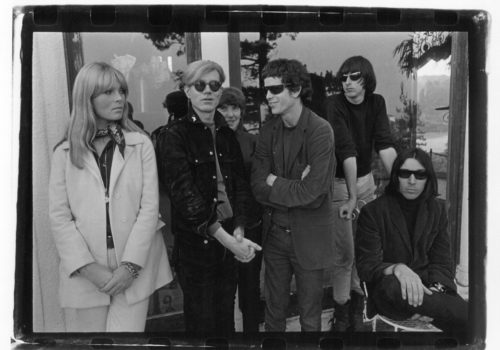Allen Ginsberg and the Beat Generation, the masters of Pop, Louise Bourgeois, Susan Sontag, Cassius Clay, James Rosenquist, the Lower East Side, Malcom X, the Tower of Light, Diane Arbus, Ed Sanders, the vestiges of Penn Station, Moondog against the war in Vietnam, New York in the 1960s, electrified experimental musicians, underground filmmakers and lovers of the extreme, Greenwich Village becoming the magnet for these talents in waiting.
The mural signed Fred McDarrah, reporter and photo-journalist for the Village Voice, at the entrance of the exhibition the Velvet Underground New York Extravaganza reminds us how avant-garde cinema and photography accompanied and played a major role in the group’s outbreak. This totally unedited and immersive exhibition at the Philharmonie de Paris which gathers archives, portraits, images in droves, alternative music and film pay tribute to these photographers, companions of legendary meteorites Jonas Mekas, Nat Finkelstein, Donald Greenhaus, Gerard Malanga, Adam Ritchie, Steve Schapiro, Steven Shore… But how is it that what was a commercial flop in 1967 (the banana album), a musical UFO, would become the foundation of modern rock and trigger an unprecedented aesthetic revolution? How did a group with such a brief existence become a substantial model for following generations up to the present day (heartfelt tributes of David Bowie, Kurt Cobain, the Stones, the Cars…).
In the beginning, there were two personalities who had nothing in common. John Cale coming from the English middle class and Lou Reed, originating from a small, middle-class Jewish family from Brooklyn, whose early instability was treated with electric shocks. Only one city could bring them together, the cosmopolitan, seedy and decadent New York. Around them gravitated guitarist Sterling Morrison, bassist Maureen Tucker, and soon to follow German actress Nico dubbed singer by Andy Warhol, who decided to take the group’s destiny into his own hands. This was the Factory, the prince of Pop’s nursery and launching pad propelling the Velvet Underground into the spotlight. Would they have had the same trajectory without this unprecedented artistic environment? That’s another question . No doubt that this exceptional breeding ground of conceptual art, underground films, tormented poetry and tribal rhythms contributed to an enabling environment even if the intransigence of tones was confusing at the time.
It was after Nico and Cale’s departure that Lou Reed was able to return to a more sensual. softer, more flexible style. And even if Reed departed in 1970 because of a certain indifference and signaled the death-knoll of the adventure, the influence of the group would never cease to grow taking posthumous revenge from Patti Smith to Iggy Pop and would soon win over other creative fields: fashion, cinema, graphics, design. Gus van Sant, Nan Goldin, John Giorno, Douglas Gordon, Jean Luc Verna to name a few. They became worthy inheritors and their lineage was manifested at the end of this road, just as unsettling as it was mind-blowing thanks to the cabins of Matali Crasset, having the space to watch and listen to parading images and sounds. The spirit of the Velvet Underground is indeed there, that of a handful of rebels, these eccentrics enamored of absolute who do not stop fascinating us with their mad, electric waves!
EXHIBITION
The Velvet Underground
New York Extravaganza
Curators : Christian Fevret (les Inrockuptibles) and Carole Mirabello (société de production : Un monde meilleur)
Until August 21st, 2015
Philarmonie de Paris
221 avenue Jean Jaurès
75019 Paris
France
http://philharmoniedeparis.fr
















